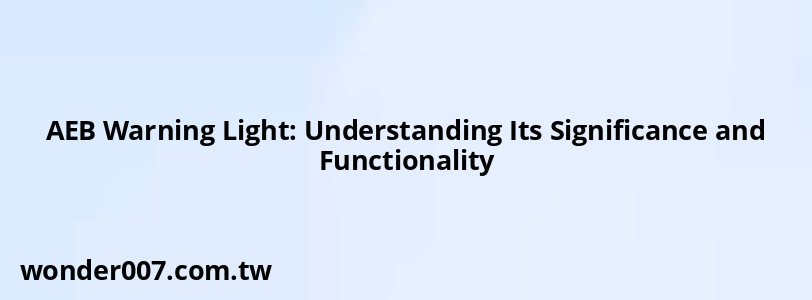AEB Warning Light: Understanding Its Significance and Functionality

The AEB (Automatic Emergency Braking) warning light is a crucial indicator in modern vehicles equipped with advanced safety systems. It alerts drivers to potential issues within the AEB system, which is designed to prevent collisions by automatically applying brakes when a potential crash is detected.
What is AEB?
AEB is a safety feature that monitors the road ahead using sensors and cameras. It aims to detect potential collisions with vehicles, pedestrians, or obstacles. When a risk is identified, the system first provides a visual and audible warning to the driver. If the driver does not respond in time, the AEB system automatically engages the brakes to either prevent or mitigate the impact of a collision.
How Does the AEB System Work?
The AEB system operates through several key components:
- Sensors: These include radar, cameras, and sometimes LiDAR, which continuously scan for obstacles.
- Warning Mechanism: Initially, the system alerts the driver with dashboard lights or sounds when a collision risk is detected.
- Automatic Braking: If no action is taken by the driver, the system applies brakes autonomously to reduce speed or stop completely.
The effectiveness of AEB varies by vehicle model and can operate at different speeds. Some systems are designed primarily for urban driving, while more advanced versions can function at higher speeds.
What Does the AEB Warning Light Indicate?
When the AEB warning light illuminates on your dashboard, it signifies that there may be an issue with the system. This could be due to:
- Sensor Obstructions: Dirt, snow, or other debris blocking sensors can cause malfunctions.
- System Malfunctions: Internal issues within the AEB system may require inspection by a professional.
- Software Errors: Occasionally, software glitches can trigger the warning light.
It's essential to address this warning promptly to ensure your vehicle's safety features are operational.
Importance of Addressing AEB Warnings
Ignoring the AEB warning light can compromise your vehicle's safety capabilities. It’s advisable to:
- Inspect Sensors: Regularly check that sensors are clean and unobstructed.
- Seek Professional Help: If the light remains on after cleaning or if you experience unexpected braking, consult a qualified technician.
Maintaining your AEB system ensures it functions correctly when needed most—potentially preventing accidents and saving lives.
FAQs About AEB Warning Light
- What should I do if my AEB warning light comes on?
Check for obstructions on sensors and consult a mechanic if necessary. - Can I drive with my AEB light on?
While you can drive, it is not recommended as it indicates possible safety feature malfunctions. - How does AEB differ from regular braking systems?
AEB automatically applies brakes in emergencies without driver intervention, unlike standard brakes that require manual action.
Related Posts
-
AC Clutch: Understanding Engagement Duration and Functionality
28-01-2025 • 136 views -
AWD Warning Light: Understanding Its Significance and Response
29-01-2025 • 231 views -
GM DTC C0561:71 - Understanding and Fixing
26-01-2025 • 126 views -
How To Reset Warning Lights On VW Tiguan
28-01-2025 • 153 views -
Kia Sorento Battery Discharge Warning: Causes & Fixes
26-01-2025 • 219 views
Latest Posts
-
Power Steering Fluid Leak On Passenger Side
01-02-2025 • 421 views -
Are O2 Sensors Covered Under Warranty
01-02-2025 • 341 views -
Rear Brake Caliper Piston Won't Compress
01-02-2025 • 317 views -
How To Turn Off Paddle Shifters Mercedes
01-02-2025 • 336 views -
2015 Chevy Traverse AC Recharge Port Location
01-02-2025 • 368 views
Popular Posts
-
EPC Light: Understanding Causes and Solutions
26-01-2025 • 1020 views -
Power Steering and ABS Light On: Causes and Solutions
27-01-2025 • 617 views -
Hino Warning Lights: Understanding Dashboard Alerts
26-01-2025 • 643 views -
EPC Warning Light: What It Means for Your Vehicle
27-01-2025 • 595 views -
V12 Engine Costs: What You Need to Know
26-01-2025 • 638 views
